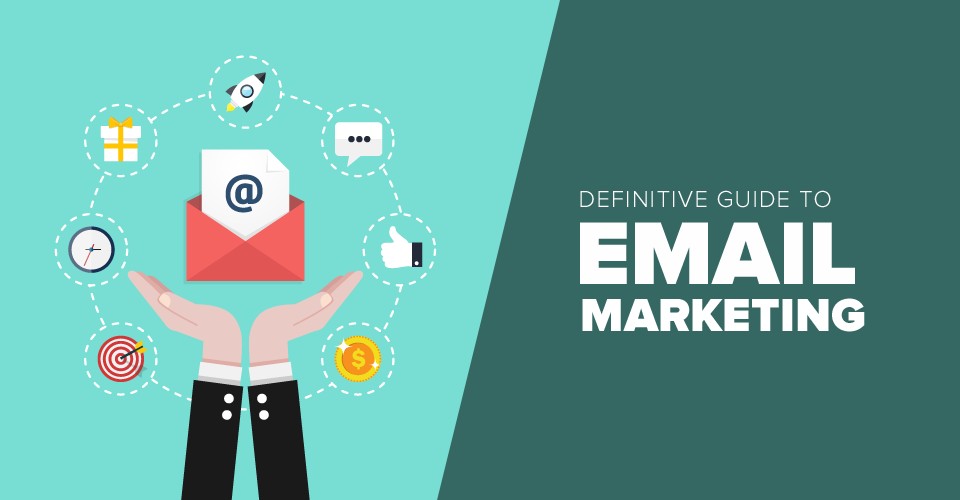Email marketing remains a potent tool for connecting with your audience, nurturing leads, and driving conversions, making a beginner’s guide to successful email marketing an essential resource. At CONDUCT.EDU.VN, we believe that mastering email marketing involves understanding key strategies such as list segmentation, personalized messaging, and campaign analysis. By implementing these tactics, you can build stronger customer relationships, improve engagement, and ultimately boost your bottom line, ensuring your email communications are both effective and compliant with best practices. Learn about email automation, targeted campaigns, and improve your communication strategy.
1. Understanding Email Marketing Fundamentals
Email marketing is a direct digital marketing strategy that leverages emails to promote a business’s products or services. It’s more than just sending emails; it’s about building relationships, providing value, and achieving specific business goals. This guide explores the core aspects of successful email marketing.
1.1. Defining Email Marketing
Email marketing involves using email to:
- Promote products and services.
- Educate potential customers.
- Announce new products or services.
- Direct customers to third-party offers.
- Share company news.
- Drive traffic to your website or blog.
1.2. Why Email Marketing Matters
Email marketing continues to thrive because:
- High ROI: Email marketing offers one of the highest returns on investment compared to other marketing channels.
- Direct Communication: It allows you to speak directly to your audience, fostering personalized engagement.
- Measurable Results: Email campaigns offer detailed analytics, helping you refine your strategy.
- Cost-Effective: It’s a relatively inexpensive way to reach a large audience.
1.3. Key Components of an Email Marketing Strategy
An effective email marketing strategy includes:
- Target Audience: Understanding who you are trying to reach.
- Email List: A collection of email addresses of individuals who have given permission to receive emails.
- Email Content: Compelling and valuable content that resonates with your audience.
- Email Design: Visually appealing design that enhances readability and engagement.
- Email Automation: Using software to send automated emails based on triggers and schedules.
- Analytics: Tracking and analyzing email performance to optimize future campaigns.
2. Setting Up Your Email Marketing Platform
Choosing the right Email Service Provider (ESP) is crucial for successful email marketing. Here’s how to select the ideal platform and configure it effectively.
2.1. Choosing an Email Service Provider (ESP)
An ESP provides the tools necessary to manage email lists, create email campaigns, and track their performance. Popular ESPs include:
- Constant Contact: Known for its user-friendly interface and excellent customer support.
- Brevo (formerly Sendinblue): Offers a comprehensive suite of marketing tools, including email, SMS, and CRM.
- HubSpot: A powerful platform integrated with CRM, ideal for B2B businesses.
- Omnisend: Designed specifically for eCommerce businesses, with robust automation features.
- Drip: Another eCommerce-focused ESP with advanced personalization capabilities.
- ConvertKit: Tailored for bloggers and content creators, offering easy-to-use automation.
- MailerLite: A budget-friendly option with a generous free plan.
- Mailchimp: One of the most popular ESPs, suitable for various businesses.
Choosing an ESP depends on your specific needs, such as budget, business type, and required features.
2.2. Setting Up Your Account
Once you’ve chosen an ESP, follow these steps to set up your account:
- Sign Up: Provide the necessary information to create your account.
- Verify Your Email: Confirm your email address to activate your account.
- Complete Your Profile: Fill out all required profile details to ensure compliance with email regulations.
- Configure Authentication: Set up SPF, DKIM, and DMARC records to improve email deliverability.
- Integrate with Your Website: Connect your ESP with your website to capture leads effectively.
2.3. Understanding Key Features
Familiarize yourself with the key features of your ESP:
- List Management: Tools for importing, segmenting, and managing your email lists.
- Email Templates: Pre-designed templates for creating professional-looking emails.
- Automation: Features for setting up automated email sequences.
- Analytics: Reporting tools for tracking email performance.
- A/B Testing: Capabilities for testing different email elements to optimize results.
- Segmentation: Organizing your email list into smaller groups.
3. Building Your Email List
Building a quality email list is essential for successful email marketing. Here are effective strategies to grow your list ethically and efficiently.
3.1. Creating Opt-in Forms
Opt-in forms are the primary method for collecting email addresses. Here are some tips for creating effective opt-in forms:
- Placement: Place opt-in forms in prominent locations on your website, such as the homepage, blog posts, and landing pages.
- Design: Use visually appealing designs that match your brand.
- Clarity: Clearly state the benefits of subscribing.
- Simplicity: Keep the form simple, asking only for essential information.
- Mobile-Friendly: Ensure the form is responsive and works well on mobile devices.
3.2. Offering Lead Magnets
A lead magnet is a valuable resource offered in exchange for an email address. Common lead magnets include:
- Ebooks: Informative guides on topics relevant to your audience.
- Checklists: Practical lists of steps or items for achieving a specific goal.
- Templates: Ready-to-use templates for various tasks.
- Webinars: Live or pre-recorded presentations on valuable topics.
- Discount Codes: Exclusive discounts for subscribers.
3.3. Promoting Your Opt-in Form
Promote your opt-in form through various channels:
- Social Media: Share your opt-in form on social media platforms.
- Website Popups: Use popups to capture visitors’ attention.
- Blog Posts: Include opt-in forms within your blog content.
- Paid Advertising: Run ads to drive traffic to your opt-in form.
- Offline Promotions: Promote your opt-in form at events and in printed materials.
3.4. Ensuring Compliance
Comply with email marketing regulations, such as GDPR, CAN-SPAM, and CCPA. These laws require:
- Consent: Obtain explicit consent before sending emails.
- Transparency: Clearly state how you will use subscribers’ email addresses.
- Unsubscribe Option: Provide an easy way for subscribers to unsubscribe from your list.
- Data Security: Protect subscribers’ data from unauthorized access.
4. Crafting Compelling Email Content
Creating valuable and engaging email content is crucial for maintaining subscriber interest and achieving your marketing goals.
4.1. Understanding Your Audience
Before writing any email, understand your audience’s needs, interests, and pain points. Consider factors such as:
- Demographics: Age, gender, location, and occupation.
- Interests: Topics and subjects that your audience cares about.
- Buying Behavior: Past purchases and browsing history.
- Feedback: Surveys, reviews, and comments from your audience.
4.2. Writing Engaging Subject Lines
The subject line is the first thing subscribers see, so it must be compelling. Tips for writing effective subject lines include:
- Clarity: Clearly state the email’s purpose.
- Urgency: Create a sense of urgency to encourage immediate action.
- Personalization: Use subscribers’ names or other personal information.
- Intrigue: Spark curiosity to entice subscribers to open the email.
- Relevance: Ensure the subject line is relevant to the email content.
4.3. Creating Valuable Email Body Content
The body of your email should provide value to your subscribers. Here are some tips for creating engaging email content:
- Personalization: Tailor the content to individual subscribers based on their interests and behavior.
- Storytelling: Use stories to connect with subscribers on an emotional level.
- Visuals: Include images, videos, and GIFs to enhance engagement.
- Conciseness: Keep the content concise and easy to read.
- Call to Action: Include a clear call to action that tells subscribers what you want them to do.
4.4. Email Content Ideas
Here are some email content ideas to keep your subscribers engaged:
- Newsletters: Share company news, industry updates, and curated content.
- Promotional Emails: Highlight special offers, sales, and new products.
- Educational Emails: Provide valuable information and insights related to your industry.
- Customer Stories: Share stories of how your products or services have helped other customers.
- Behind-the-Scenes: Give subscribers a glimpse into your company culture and operations.
5. Designing Effective Emails
Email design plays a crucial role in capturing subscribers’ attention and driving engagement.
5.1. Email Layout and Structure
A well-structured email is easy to read and visually appealing. Here are some tips for email layout and structure:
- Header: Include your company logo and branding.
- Body: Use clear headings, subheadings, and bullet points to organize the content.
- Images: Use high-quality images that are relevant to the content.
- Footer: Include your company contact information, social media links, and an unsubscribe link.
5.2. Mobile Optimization
Ensure your emails are optimized for mobile devices. Tips for mobile optimization include:
- Responsive Design: Use a responsive email template that adapts to different screen sizes.
- Font Size: Use a large enough font size for easy reading on mobile devices.
- Button Size: Make buttons large enough to tap easily on touchscreens.
- Image Size: Optimize images for mobile devices to reduce loading times.
5.3. Branding Consistency
Maintain consistent branding across all your emails. This includes using the same:
- Logo: Use your company logo consistently in the header and footer of your emails.
- Colors: Use your brand colors throughout the email design.
- Fonts: Use your brand fonts for headings and body text.
- Tone: Maintain a consistent tone of voice in your email content.
5.4. Using Visuals Effectively
Visuals can enhance engagement and convey your message more effectively. Here are some tips for using visuals in your emails:
- Relevance: Use images and videos that are relevant to the email content.
- Quality: Use high-quality visuals that are visually appealing.
- Optimization: Optimize images for email to reduce file size and loading times.
- Alt Text: Add alt text to images for accessibility and SEO purposes.
6. Email Automation and Segmentation
Automation and segmentation are powerful tools for delivering personalized and relevant email experiences.
6.1. Setting Up Automated Email Sequences
Automated email sequences are a series of emails triggered by specific actions or events. Common automated email sequences include:
- Welcome Series: A series of emails sent to new subscribers.
- Lead Nurturing: Emails sent to potential customers who have shown interest in your product or service.
- Abandoned Cart: Emails sent to customers who have left items in their shopping cart.
- Post-Purchase: Emails sent to customers after they have made a purchase.
6.2. Segmenting Your Email List
Segmentation involves dividing your email list into smaller groups based on specific criteria. Common segmentation criteria include:
- Demographics: Age, gender, location, and occupation.
- Interests: Topics and subjects that your audience cares about.
- Buying Behavior: Past purchases and browsing history.
- Engagement: Subscribers who have opened or clicked on previous emails.
6.3. Personalizing Email Content
Personalization involves tailoring email content to individual subscribers based on their specific characteristics and behavior. Common personalization techniques include:
- Using Subscribers’ Names: Address subscribers by their first name in the email subject line and body.
- Customizing Content: Tailor the email content to subscribers’ interests and buying behavior.
- Sending Targeted Offers: Send offers that are relevant to subscribers’ past purchases.
6.4. Using Automation to Improve Engagement
Automation can be used to improve email engagement in various ways:
- Sending Triggered Emails: Send emails based on specific actions or events.
- Personalized Recommendations: Provide personalized product or content recommendations.
- Dynamic Content: Use dynamic content to display different content to different subscribers based on their characteristics.
7. Testing and Optimizing Your Email Campaigns
Testing and optimizing your email campaigns is essential for maximizing their effectiveness.
7.1. A/B Testing
A/B testing involves testing two versions of an email to see which performs better. Common elements to A/B test include:
- Subject Lines: Test different subject lines to see which generates the highest open rate.
- Email Content: Test different content to see which generates the highest click-through rate.
- Call to Action: Test different calls to action to see which generates the most conversions.
- Images: Test different images to see which generates the most engagement.
7.2. Analyzing Email Metrics
Track key email metrics to understand the performance of your campaigns. Common email metrics include:
- Open Rate: The percentage of subscribers who opened your email.
- Click-Through Rate: The percentage of subscribers who clicked on a link in your email.
- Conversion Rate: The percentage of subscribers who completed a desired action, such as making a purchase.
- Bounce Rate: The percentage of emails that could not be delivered.
- Unsubscribe Rate: The percentage of subscribers who unsubscribed from your list.
7.3. Using Data to Refine Your Strategy
Use the data you collect to refine your email marketing strategy. This includes:
- Identifying High-Performing Emails: Analyze your email metrics to identify your most successful emails.
- Understanding Subscriber Behavior: Understand how subscribers are engaging with your emails.
- Optimizing Your Segmentation: Refine your segmentation criteria to improve targeting.
- Adjusting Your Content Strategy: Tailor your content to better meet subscribers’ needs.
7.4. Avoiding Common Mistakes
Avoid these common email marketing mistakes:
- Sending Emails Without Permission: Always obtain explicit consent before sending emails.
- Using Spammy Subject Lines: Avoid using words that trigger spam filters.
- Not Providing an Unsubscribe Option: Always include an easy way for subscribers to unsubscribe from your list.
- Not Testing Your Emails: Always test your emails before sending them to your entire list.
- Ignoring Email Metrics: Always track and analyze your email metrics to optimize your campaigns.
8. Overcoming Email Marketing Challenges
Effective email marketing has challenges. Here’s how to address them:
8.1. Building an Email List
Getting people on your list can be challenging. Clearly explain the benefits of joining your list. Adjust your call to action to focus on these benefits. Use social proof by showing how many people have already signed up.
8.2. Ensuring Email Deliverability
Making sure your emails land in the inbox is crucial. Average deliverability rates are around 81%. Follow email deliverability best practices to ensure your emails reach the right inbox. Avoid spammy words, clean your email list regularly, segment your emails, and provide subscription management options.
8.3. Improving Email Open Rates
The average open rate is around 21%. Improve your email open rates by writing and sending high-quality emails. Make your subject lines exciting and informative. Use preview text to provide extra insight. Optimize your email design, especially for mobile devices.
8.4. Boosting Email Conversion Rates
If subscribers are receiving and opening your emails but not clicking or buying, you need to boost conversion rates. The average email conversion rate ranges from 0.1% to over 3%. Improve conversion rates by tuning into your audience’s needs and wants.
8.5. Scaling Email Marketing
As you add more subscribers, offers, and promotions, your email marketing will get more complex. Work smarter, not harder. Build on what already works.
8.6. Running Multilingual Campaigns
Reach a global audience in their native languages. The “Can’t Read, Won’t Buy – B2C” study revealed that 65% of respondents prefer content in their native language. Collect and segment your multilingual leads for multilingual campaigns.
9. Case Studies: Successful Email Marketing Campaigns
Explore real-world examples of successful email marketing campaigns and the strategies behind them.
9.1. E-Commerce: Increasing Sales Through Personalized Recommendations
An e-commerce company used personalized product recommendations in their email campaigns to increase sales. By analyzing customer purchase history and browsing behavior, they sent targeted emails with products that each customer was likely to be interested in. This resulted in a 20% increase in sales and improved customer loyalty.
9.2. SaaS: Improving Trial Conversions with Targeted Onboarding Emails
A SaaS company improved trial conversions by sending targeted onboarding emails to new users. These emails provided valuable tips, tutorials, and case studies to help users get the most out of the software. By personalizing the content based on user behavior, the company increased trial conversions by 15%.
9.3. Non-Profit: Boosting Donations with Compelling Storytelling
A non-profit organization boosted donations by using compelling storytelling in their email campaigns. They shared stories of how donations were making a difference in the lives of people they serve. By connecting with donors on an emotional level, they increased donations by 25%.
10. Frequently Asked Questions (FAQs)
Address common questions about email marketing to provide further clarity and guidance.
10.1. When is the best time to send a marketing email?
The best time to send a marketing email is between 9 AM to 12 PM on Monday, Tuesday, and Wednesday, according to a HubSpot study. However, testing different times can help you find when your audience is most active.
10.2. What is a good open rate for email marketing?
A good open rate is between 15% and 25%, but it varies by industry. Focus on improving engagement and personalization to enhance your open rates.
10.3. How often should I send marketing emails?
Send emails at a consistent frequency without overwhelming subscribers. Start with once a week or bi-weekly, and adjust based on feedback and engagement metrics.
10.4. What email metrics should I track?
Track open rates, click-through rates, conversion rates, bounce rates, and unsubscribe rates. Also, monitor deliverability, spam complaints, and list growth rate.
10.5. What is the difference between single opt-in and double opt-in?
Single opt-in immediately adds subscribers to the list. Double opt-in requires confirmation via a verification email. Double opt-in ensures higher quality but may result in fewer subscribers.
Conclusion: Your Journey to Email Marketing Success
Email marketing, when done right, can be a game-changer for your business. By following this a beginner’s guide to successful email marketing, you can build a thriving email list, create compelling content, and drive meaningful results. Remember to stay compliant with regulations and continuously optimize your strategy based on data and feedback.
At CONDUCT.EDU.VN, we are committed to providing you with the knowledge and tools you need to succeed. If you have any questions or need further assistance, don’t hesitate to contact us at 100 Ethics Plaza, Guideline City, CA 90210, United States. Reach out via WhatsApp at +1 (707) 555-1234 or visit our website conduct.edu.vn for more resources and guidance. Let’s embark on this journey together and unlock the full potential of email marketing for your business! By learning about targeted advertising, list building tactics and email deliverability you will be on the right path.


